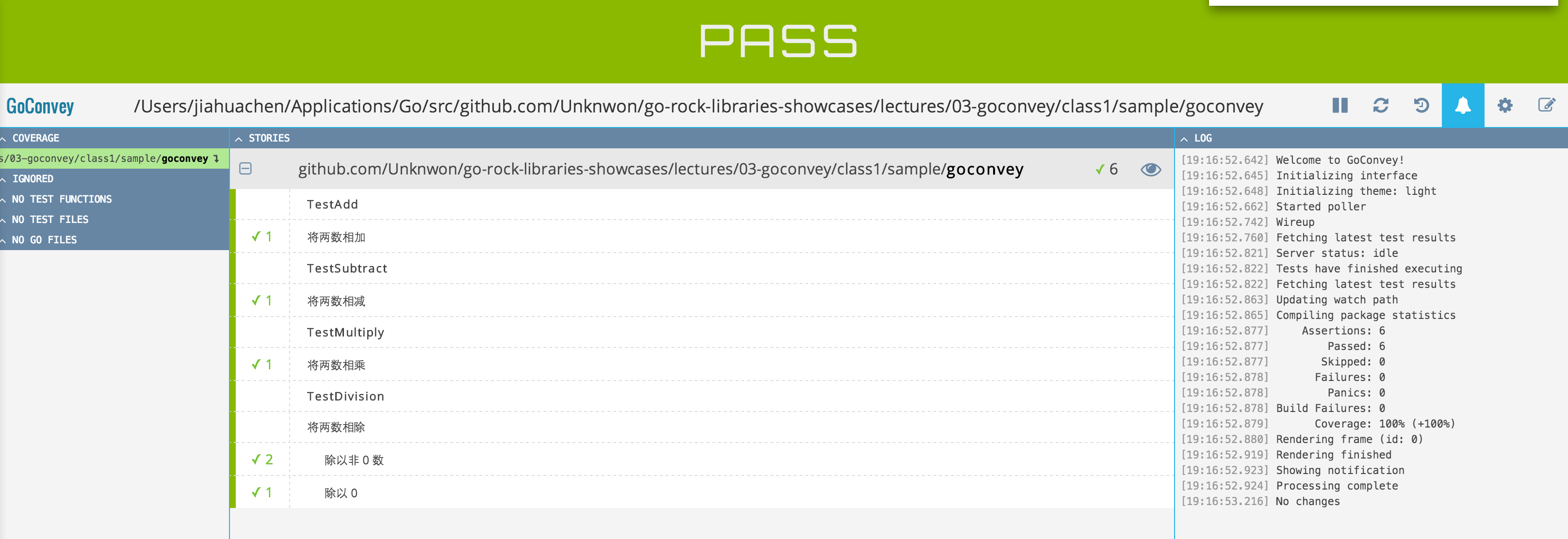Introduction Link to heading
Go comes with built-in unit test feature, and there are lots of third-party helper libraries before GoConvey was born. Unfortunately, none of them can help you write elegant test cases like GoConvey does, simple syntax and comfortable interface make you fall in love with writing unit tests.
Installation Link to heading
go get github.com/smartystreets/goconvey
API Documentation Link to heading
Please visit Go Walker.
Basic Usages Link to heading
Write the code Link to heading
Following code shows an example of basic four arithmetic(Add, subtract, multiply, divide):
package goconvey
import (
"errors"
)
func Add(a, b int) int {
return a + b
}
func Subtract(a, b int) int {
return a - b
}
func Multiply(a, b int) int {
return a * b
}
func Division(a, b int) (int, error) {
if b == 0 {
return 0, errors.New("can not divide by zero")
}
return a / b, nil
}
In the code above, we implemented 4 functions, now we will use GoConvey to write test cases for them:
package goconvey
import (
"testing"
. "github.com/smartystreets/goconvey/convey"
)
func TestAdd(t *testing.T) {
Convey("Add two numbers", t, func() {
So(Add(1, 2), ShouldEqual, 3)
})
}
func TestSubtract(t *testing.T) {
Convey("Subtract one from another", t, func() {
So(Subtract(1, 2), ShouldEqual, -1)
})
}
func TestMultiply(t *testing.T) {
Convey("Multiply two numbers", t, func() {
So(Multiply(3, 2), ShouldEqual, 6)
})
}
func TestDivision(t *testing.T) {
Convey("Divide one from another", t, func() {
Convey("Divide by non-zero number", func() {
num, err := Division(10, 2)
So(err, ShouldBeNil)
So(num, ShouldEqual, 5)
})
Convey("Divide by zero", func() {
_, err := Division(10, 0)
So(err, ShouldNotBeNil)
})
})
}
First of all, you should use the way that GoConvey team recommands to reduce redundant code: . "github.com/smartystreets/goconvey/convey".
Every test function has to start with Test, such as TestAdd, and needs a *testing.T type argument.
To use GoConvey, every test case should use Convey function to start with. Its first argument is a string type argument; the second arguement usually is *testing.T, which is the varible t in this case; the third argument is a function with no argument and no return values(commonly use as closures).
You can have infinite nested Convey statements to present relationships between test cases. In the example, TestDivision function uses this way to shows the relations. Note that, only the out-most level need to pass varible t, and no need for other levels.
Finally, you can use So statement to test conditions. In this example, there are three different kinds of conditions: ShouldBeNil, ShouldEqual and ShouldNotBeNil, each represents value should be nil, values should equal, and value should not be nil. For more built-in conditions, please see Documentation.
Run the tests Link to heading
Now you can open the terminal and type go test -v to run the tests. Because GoConvey compatibles with Go built-in unit test, we can directly use Go commands to execute tests.
Following content comes from the output of test cases of the example(Mac):
=== RUN TestAdd
Add two numbers ✔
1 assertion thus far
--- PASS: TestAdd (0.00 seconds)
=== RUN TestSubtract
Subtract one from another ✔
2 assertions thus far
--- PASS: TestSubtract (0.00 seconds)
=== RUN TestMultiply
Multiply two numbers ✔
3 assertions thus far
--- PASS: TestMultiply (0.00 seconds)
=== RUN TestDivision
Divide one from another
Divide by non-zero number ✔✔
Divide by zero ✔
6 assertions thus far
--- PASS: TestDivision (0.00 seconds)
PASS
ok github.com/Unknwon/go-rock-libraries-showcases/lectures/03-goconvey/class1/sample/goconvey 0.009s
As you can see, the output has very simple and understandable format, and test code are very elegant. But, is that all? Of course not! GoConvey has a very nice web interface to help automated testing as well.
Web Interface Link to heading
To enable web interface of GoConvey, you need to execute goconvey(install by go get to $GOPATH/bin), then open the browser and visit http://localhost:8080:

In the web interface, you can custom theme, see complete test results, browser notifications, etc.
Other features:
- Monitor code change and run tests
- Expressive DSL: http://localhost:8080/composer.html
- Coverage report: http://localhost:8080/reports/
- Stop monitoring a package
Summary Link to heading
At this point, you should have a sense of how to use GoConvey to write awesome test cases, and how it makes boring work to be interesting.
Packages use GoConvey Link to heading
To study in action, here is the list of packages that use GoConvey to write test cases: